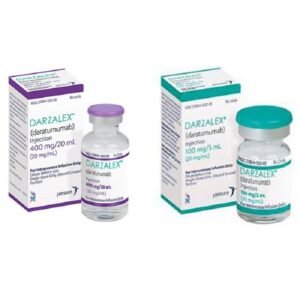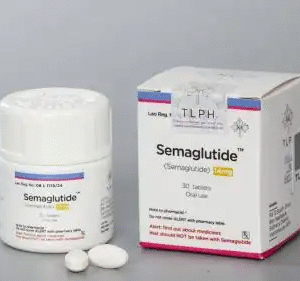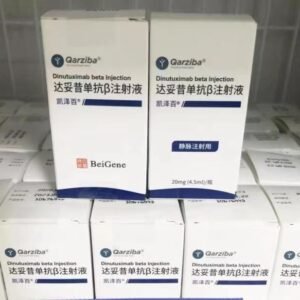Daratumumab Injection(Subcutaneous Injection)
Function and indication:
[Indications] This product is suitable for: (1) Combination with lenalidomide and dexamethasone or bortezomib, melphalan and prednisone for the treatment of newly diagnosed adult patients with multiple myeloma who are not suitable for autologous stem cell transplantation. (2) Combination with lenalidomide and dexamethasone or bortezomib and dexamethasone for the treatment of adult patients with multiple myeloma who have received at least one line of treatment. (3) Monotherapy for adult patients with relapsed and refractory multiple myeloma who have previously received treatment including proteasome inhibitors and immunomodulators and have disease progression at the time of the last treatment.
Dosage and Administration: This product should be administered by medical personnel in conditions equipped with resuscitation facilities. Usage: Pre- and post-infusion medications should be given to reduce the risk of infusion-related reactions (IRR) of this product. See “Recommended Concomitant Medication”, “Management of Infusion-Related Reactions” and [Precautions] below. Dosage Standard dosing regimen for combination therapy with lenalidomide (4-week dosing regimen) and monotherapy: The recommended dose of this product is 16 mg/kg, intravenous infusion, and the dosing schedule is shown in Table 1. Table 1: Standard dosing regimen for combination therapy with lenalidomide (4-week dosing regimen) and monotherapy Week Dosing regimen Week 1-8 Once a week (8 doses in total) Week 9-24a Once every 2 weeks (8 doses in total) From Week 25 until disease progressionb Once every 4 weeksa The first dose of the once every 2 weeks dosing regimen is in Week 9. b The first dose of the once every 4 weeks dosing regimen is in Week 25. For the dose and dosing schedule of drugs used in combination with this product, see [Clinical Trials]. Dosing regimen for combination therapy with bortezomib, melphalan and prednisone (6-week dosing regimen): The recommended dose of this product is 16 mg/kg, intravenous infusion, and the dosing schedule is shown in Table 2. Table 2: Dosing regimen for combination therapy of this product with bortezomib, melphalan and prednisone (VMP) (dosing regimen for a 6-week cycle) Weekly Dosing Regimen Weeks 1-6 Once a week (a total of 6 doses) Weeks 7-54a Once every 3 weeks (a total of 16 doses) From Week 55 until disease progressionb Once every 4 weeksa The first dose of the once every 3 weeks regimen is Week 7b The first dose of the once every 4 weeks regimen is Week 55 Bortezomib is given twice a week in Weeks 1, 2, 4 and 5 of the first 6-week cycle, and once a week in Weeks 1, 2, 4 and 5 of the next 8 6-week cycles. For the dosage and dosing regimen of drugs used in combination with this product, see [Clinical Trials]. Dosing regimen for combination therapy with bortezomib (dosing regimen for a 3-week cycle): The recommended dose of this product is 16 mg/kg, intravenous infusion, and the dosing schedule is shown in Table 3. Table 3: Dosing regimen for combination therapy with bortezomib (3-week dosing regimen) Weekly dosing regimen Weeks 1-9 Once a week (9 doses in total) Weeks 10-24a Once every 3 weeks (5 doses in total) From week 25 until disease progressionb Once every 4 weeksa The first dose of the once every 3 weeks regimen is in week 10b The first dose of the once every 4 weeks regimen is in week 25 For the dose and dosing regimen of drugs used in combination with bortezomib, see [Clinical Trials]. Infusion rate After dilution, bortezomib should be infused intravenously at the initial infusion rate listed in Table 4 below. Increasing the infusion rate should only be considered in the absence of infusion-related reactions. For ease of administration, the first dose of the drug in the first week (dose 16 mg/kg) can be divided into two consecutive days, i.e., 8 mg/kg on days 1 and 2, see Table 4 below. Table 4: Infusion Rates for Administration of Indole (16 mg/kg) Dilution Volume Initial Rate (1st hour) Rate Incrementa Maximum Rate Week 1 Infusion Regimen 1 (Single Infusion) Week 1 Day 1 (16 mg/kg) 1,000 mL 50 mL/hour 50 mL/hour, 200 mL/hour per hour Regimen 2 (Fraction Infusion) Week 1 Day 1 (8 mg/kg) 500 mL 50 mL/hour 50 mL/hour, 200 mL/hour per hour Week 1 Day 2 (8 mg/kg) 500 mL 50 mL/hour 50 mL/hour, 200 mL/hour per hour L/hour, 200 mL/hour per hour Week 2 (16 mg/kg) infusionb500 mL50 mL/hour50 mL/hour, 200 mL/hour Subsequent (starting Week 3, 16 mg/kg) infusionc500 mL100 mL/hour50 mL/hour, 200 mL/hour per hour Table 4: Infusion Rates for Administration of Intravenous Injection (16 mg/kg) Dilution Volume Initial Rate (1st Hour) Rate Incrementa Maximum Ratea Consider increasing the infusion rate only if there were no infusion-related reactions (IRRs). b Use a 500 mL dilution volume only if no IRR occurred following administration of 16 mg/kg in the previous week. Otherwise, use a 1000 mL dilution volume. c Use an adjusted initial rate (100 mL/hour) for subsequent infusions (i.e., starting in Week 3) only if no IRR occurred during the previous infusion. Otherwise, continue with subsequent infusions at the Week 2 infusion rate shown in the table. Management of Infusion-Related Reactions Before treatment with levofloxacin, premedication should be given to reduce the risk of infusion-related reactions (IRRs). For any grade/severity of IRR, the levofloxacin infusion should be interrupted immediately and symptomatic treatment should be given. Treatment of IRRs may also require a reduction in the infusion rate or discontinuation of levofloxacin, as described below (see Precautions). • Grade 1-2 (mild to moderate): After the symptoms of the infusion-related reaction subside, consider restarting the infusion, but the rate should not exceed half of the infusion rate at the time of the IRR. If the patient does not experience any further symptoms of the IRR, the infusion rate can continue to be increased, with the increment and interval depending on the clinical situation, up to a maximum rate of 200 mL/hour (Table 4). • Grade 3 (severe): After the symptoms of the infusion-related reaction subside, consider restarting the infusion, but the rate should not exceed half of the infusion rate at the time of the IRR. If the patient does not experience additional symptoms, the increased infusion rate can be restarted, with the increment and interval depending on the clinical situation (Table 4). If Grade 3 symptoms recur, the above steps should be repeated. If a third infusion-related reaction of ≥ Grade 3 occurs, treatment with this product should be permanently discontinued. • Grade 4 (life-threatening): Permanently discontinue treatment with this product. Missed dose If this product is not infused as planned, it should be supplemented as soon as possible and the dosing regimen should be adjusted accordingly to maintain the dosing interval of treatment. Dose adjustment It is not recommended to reduce the dose of this product. If hematological toxicity occurs, dosing may need to be delayed to allow blood cell counts to recover (see [Precautions]). Recommended concomitant medication Pre-infusion medication Give all patients the following pre-infusion medication 1-3 hours before each infusion of this product to reduce the risk of IRR: Corticosteroids (long-acting or intermediate-acting) – Monotherapy: IV infusion of 100 mg methylprednisolone or equivalent. After the second infusion, the corticosteroid dose can be reduced (methylprednisolone 60 mg orally or intravenously). – Combination therapy: Administer 20 mg dexamethasone or equivalent before each infusion of this product. When dexamethasone is a corticosteroid prescribed as part of the background regimen, it will be used as a pre-infusion medication for VAX on the day of infusion (see Clinical Trials). Dexamethasone should be administered intravenously prior to the first infusion of VAX and may be considered for oral administration prior to subsequent infusions. If patients receive dexamethasone as pre-medication, no additional corticosteroids prescribed as part of the background regimen (e.g., prednisone) should be administered on the day of VAX infusion. • Antipyretics (acetaminophen 650 to 1,000 mg orally). • Antihistamines (diphenhydramine 25 to 50 mg orally or intravenously or equivalent). Post-infusion medications The following post-infusion medications should be administered to reduce the risk of delayed infusion-related reactions: – Monotherapy: Administer oral corticosteroids (20 mg methylprednisolone or an equivalent intermediate- or long-acting corticosteroid, as determined by local standards) daily for 2 days following each infusion of VAX (starting the day after the infusion). -Combination therapy: Consider administering low-dose oral methylprednisolone (≤20 mg) or equivalent the day after the infusion of this product. However, if background regimen-mandated corticosteroids (e.g., dexamethasone and prednisone) are used the day after the infusion of this product, additional post-infusion medications may not be required (see [Clinical Trials]). In addition, post-infusion medications including short-acting and long-acting bronchodilators and inhaled corticosteroids should be considered for patients with a history of chronic obstructive pulmonary disease. After the first four infusions, if the patient does not experience a major IRR, these inhaled post-infusion medications can be discontinued at the discretion of the physician. Prevention of herpes zoster virus reactivation Antiviral prophylaxis should be considered to prevent herpes zoster virus reactivation. Special Populations Renal Impairment Formal studies of this product have not been conducted in subjects with renal impairment. Based on population pharmacokinetic (PK) analysis, no dose adjustment is required in patients with renal impairment (see [Pharmacokinetics]). Hepatic Impairment Formal studies of this product have not been conducted in subjects with hepatic impairment. Based on population PK analysis, no dose adjustment is required for patients with hepatic impairment (see [Pharmacokinetics]). Elderly Elderly patients do not need to adjust their dose (see [Geriatric Use] and [Pharmacokinetics]). Children There is no clinical research data on this product for patients under 18 years of age. Administration This product is administered intravenously. Dilute with 9 mg/mL (0.9%) sodium chloride injection and infuse intravenously. The dilution instructions for this product before administration are as follows. This product is for single use only. When preparing the infusion, please use the following aseptic techniques: • Calculate the required dose (mg) and total volume (mL) of this product solution based on the patient’s weight, as well as the number of this product tubes to be used. • Check to confirm that this product solution is colorless to light yellow. If opaque particles, discoloration, or other foreign particles are present, it must not be used. • Using aseptic techniques, draw a certain volume of 0.9% sodium chloride solution from the infusion bag/container, and the volume drawn is equal to the required volume of this product solution. • Draw the required volume of this product solution and add it to the infusion bag/container containing 0.9% sodium chloride solution to dilute to the appropriate volume. The infusion bag/container must be made of polyvinyl chloride (PVC), polypropylene (PP), polyethylene (PE), or a polyolefin blend (PP+PE). Dilution should be performed under appropriate aseptic conditions. Any unused portion remaining in the bottle should be discarded. • Gently invert the infusion bag/container to mix the solution. Do not shake. Before use, visually inspect the injectable drug for suspended particles or discoloration. Since daratumumab is a protein, the diluted solution may produce very fine translucent to white protein particles. If opaque particles, discoloration, or foreign particles are observed, do not use. • Since this product does not contain a preservative, the diluted solution stored at room temperature (15°C-25°C) and room lighting conditions should be infused within 15 hours (including the infusion time). • If it cannot be used immediately, the diluted solution can be stored in the dark under refrigerated conditions (2°C-8°C) for no more than 24 hours before administration. Freezing is prohibited. • The diluted solution should be administered intravenously using an infusion set equipped with a flow regulator and a sterile, non-pyrogenic, low protein binding polyethersulfone (PES) filter (pore size 0.22 or 0.2 micron) in the tubing. Polyurethane (PU), polybutadiene (PBD), PVC, PP, or PE infusion sets must be used. • Do not infuse this product with other drugs in the same intravenous line. • Do not save unused infusion solution for later use. All unused drug products or waste materials should be disposed of in accordance with local requirements.
Adverse Reactions:
The pooled safety data set reflects exposure to daratumumab (16 mg/kg) in 2,397 subjects with multiple myeloma, including 203 from daratumumab monotherapy (n=47 [Study MMY1003]; n=106 [Study MMY2002]; n=45 [Study GEN501]; n=5 [Study MMY1002]) and 2,194 from daratumumab combination therapy The safety data described below reflect exposure of patients (n=2,397) to 16 mg/kg of tadalafil in 13 pooled clinical trials of tadalafil. The most common adverse reactions (≥20%) include neutropenia, upper respiratory tract infection, infusion-related reactions, thrombocytopenia, anemia, diarrhea, constipation, peripheral sensory neuropathy, cough, peripheral edema, nausea, fever, fatigue and dyspnea. Common serious adverse reactions (≥1%) are infectious pneumonia, fever, thrombocytopenia and neutropenia. Adverse reaction list Table 5 summarizes the adverse reactions in patients treated with this product. The frequency of occurrence is defined as: very common (≥1/10), common (≥1/100 to <1/10), occasional (≥1/1,000 to <1/100), rare (≥1/10,000 to <1/1,000) and very rare (<1/10,000). Adverse reactions in each group are arranged in descending order of severity. Table 5: Adverse Reactions in Patients with Multiple Myeloma Received Daratumumab 16 mg/kg Monotherapy or in Combination Therapy; Pooled Adverse Reactions Safety Data Set System Organ Class Frequency of Adverse Reactions (Any Grade) Incidence Any Grade Grade 3-4 Infections and Infections Upper Respiratory Tract Infectiona Very Common 41% 4% Pneumoniaa Very Common 19% 13% Bronchitisa Very Common 16% 2% Urinary Tract Infection Common 7% 1% Influenza Common 4% 1% # Sepsisa Common 4% 3% Cytomegalovirus Infectiona Common 1% < 1% # Hepatitis B Virus Reactivationb Uncommon Blood and Lymphatic System Disorders Neutropeniaa Very Common 47% 37% Thrombocytopeniaa Very Common 38% 23% Anemiaa Very Common 33% 14% Leukocyte Cytopeniaa Very common 19%9% Lymphocytopeniaa Very common 19%15% Immune system diseases Hypogammaglobulinemiaa Common 2%<1% # Metabolic and nutritional diseases Loss of appetite Very common 11%1% Hyperglycemia Very common 11%3% Hypocalcemia Common 9%2% Dehydration Common 2%1% # Various nervous system diseases Peripheral sensory neuropathy Very common 30%3% Headache Very common 11%<1% # Paresthesia Very common 10%<1% Syncope Common 2%1% # Heart disease Atrial fibrillation Common 3%1% Vascular disease Hypertensiona Very common 12%6% Respiratory, thoracic and mediastinal diseases Cougha Very common 25%<1% # Dyspneaa Very common 20%3% Pulmonary edemaa Common 1%<1% Gastrointestinal system
Share:
Products
Our offers
Health Classification
Let us work together to protect precious health






























